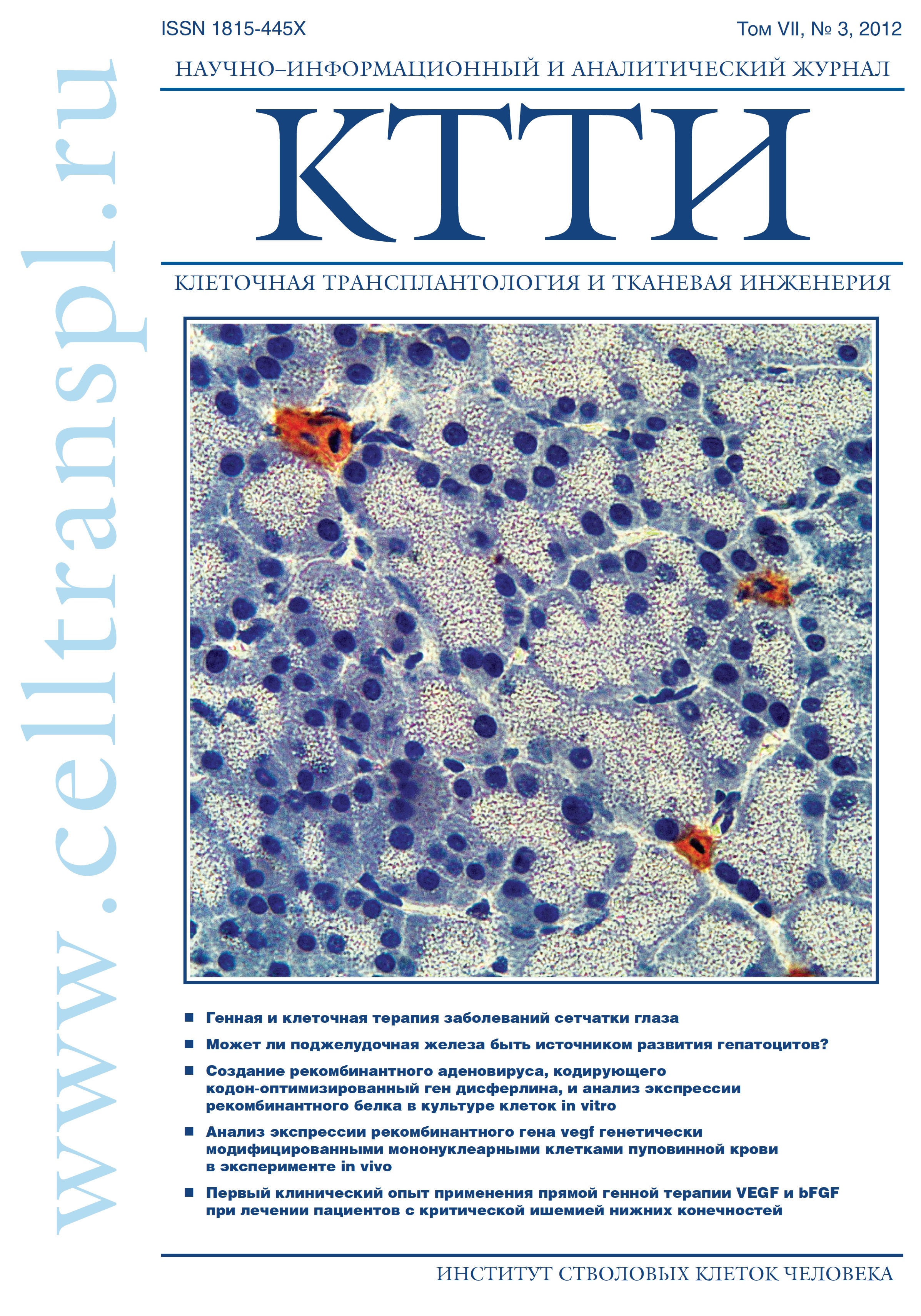Influence of recombinant histone H1.3 on the efficiency of lentiviral transduction of human cells in vitro
- Authors: Solovyeva VV1, Isaev AA2, Genkin DD3, Rizvanov AA1
-
Affiliations:
- Kazan (Volga region) federal university, Kazan
- Human Stem Cells Institute, Moscow
- OJSC «Pharmsynthez», Saint-Petersburg
- Issue: Vol 7, No 3 (2012)
- Pages: 151-154
- Section: Articles
- URL: https://genescells.ru/2313-1829/article/view/121657
- DOI: https://doi.org/10.23868/gc121657
- ID: 121657
Cite item
Abstract
Lentiviral vectors are widely used in genetic modification
of human and animal cells (lentiviral transduction) to enhance
their therapeutic potential by expression of recombinant
protective and trophic factors. Genetic modification of cells in
vitro or ex vivo achieves the specificity of viral transduction,
as modified are just cells that have been manipulated in
the laboratory. In addition, the introduction of genetically
modified cells, but not pure virus, helps to avoid introduction
of viral particles into the body of the recipient. This approach
allows us to control the expression of therapeutic genes, the
immunogenicity of viral vectors and viral transduction. To
date, different approaches are used to improve the lentiviral
transduction (polycations, protamine sulfate, etc.), but these
methods suffer from limited efficacy or high toxicity. For the
first time we demonstrated that the recombinant histone
N1.3 increases the efficiency of lentiviral transduction by
more than 2 times and has no toxic effect on target cells in
a wide range of concentrations studied.
of human and animal cells (lentiviral transduction) to enhance
their therapeutic potential by expression of recombinant
protective and trophic factors. Genetic modification of cells in
vitro or ex vivo achieves the specificity of viral transduction,
as modified are just cells that have been manipulated in
the laboratory. In addition, the introduction of genetically
modified cells, but not pure virus, helps to avoid introduction
of viral particles into the body of the recipient. This approach
allows us to control the expression of therapeutic genes, the
immunogenicity of viral vectors and viral transduction. To
date, different approaches are used to improve the lentiviral
transduction (polycations, protamine sulfate, etc.), but these
methods suffer from limited efficacy or high toxicity. For the
first time we demonstrated that the recombinant histone
N1.3 increases the efficiency of lentiviral transduction by
more than 2 times and has no toxic effect on target cells in
a wide range of concentrations studied.
Keywords
About the authors
V V Solovyeva
Kazan (Volga region) federal university, KazanKazan (Volga region) federal university, Kazan
A A Isaev
Human Stem Cells Institute, MoscowHuman Stem Cells Institute, Moscow
D D Genkin
OJSC «Pharmsynthez», Saint-PetersburgOJSC «Pharmsynthez», Saint-Petersburg
A A Rizvanov
Kazan (Volga region) federal university, KazanKazan (Volga region) federal university, Kazan
References
- Seroogy C.M., Fathman C.G. The application of gene therapy in autoimmune diseases. Gene Ther. 2000; 7(1): 9-13.
- Kohn D.B., Bauer G., Rice C.R. et al., A clinical trial of retroviral-mediated transfer of a rev-responsive element decoy gene into CD34(+) cells from the bone marrow of human immunodeficiency virus-1-infected children. Blood 1999; 94(1): 368-71.
- Nemunaitis J., Fong T., Robbins J.M. et al. Phase I trial of interferon-gamma (IFN-gamma) retroviral vector administered intratumorally to patients with metastatic melanoma. Cancer GeneTher. 1999; 6(4): 322-30.
- Shand N., Weber F., Mariani L. et al. A phase 1-2 clinical trial of gene therapy for recurrent glioblastoma multiforme by tumor transduction with the herpes simplex thymidine kinase gene followed by ganciclovir. GLI328 European-Canadian Study Group. Hum. Gene Ther. 1999; 10(14): 2325-35.
- Duc-Nguyen H., Enhancing effect of diethylaminoethyl-dextran on the focus-forming titer of a murine sarcoma virus (Harvey strain).
- J. Virol. 1968; ([6): 643-4.
- Manning J.S., Hackett A.J., Darby N.B. Effect of polycations on sensitivity of BALD-3T3 cells to murine leukemia and sarcoma virus infectivity. Appl. Microbiol. 1971; 22(6): 1162-3.
- Cornetta K., Anderson W.F. Protamine sulfate as an effective alternative to polybrene in retroviral-mediated gene-transfer: implications for human gene therapy. J. Virol. Methods. 1989; 23(2): 187-94.
- Zaitsev S., Buchwalow I., Haberland A. et al. Histone H1- mediated transfection: role of calcium in the cellular uptake and intracellular fate of H1-DNA complexes. Acta Histochem. 2002; 104(1): 85-92.
- Budker V., Hagstrom J.E., Lapina O. et al. Protein/amphipathic polyamine complexes enable highly efficient transfection with minimal toxicity. Biotechniques 1997; 23(1): 139: 142-7.
- Fritz J.D., Herweijer H., Zhang G. et al. Gene transfer into mammalian cells using histone-condensed plasmid DNA. Hum. Gene Ther. 1996; 7(12): 1395-404.
- Haberland A., Knaus T., Zaitsev S.V. et al. Histone H1-mediated transfection: serum inhibition can be overcome by Ca2+ ions. Pharm. Res. 2000; 17(2): 229-35.
- Lucius H., Haberland A., Zaitsev S. et al. Structure of transfection-active histone H1/DNA complexes. Mol. Biol. Rep. 2001; 28(3): 157-65.
- Zaitsev S.V., Haberland A., Otto A. et al. H1 and HMG17 extracted from calf thymus nuclei are efficient DNA carriers in gene transfer. Gene Ther. 1997; 4(6): 586-92.
- Demirhan I., Hasselmayer O., Chandra A. et al., Histonemediated transfer and expression of the HIV-1 tat gene in Jurkat cells.
- J. Hum. Virol. 1998; 1(7): 430-40.
- Bottger M., Zaitsev S.V., Otto A. et al., Acid nuclear extracts as mediators of gene transfer and expression. Biochim. Biophys. Acta. 1998; 1395(1): 78-87.
- Puebla I., Esseghir S., Mortlock A. et al. A recombinant H1 histone-based system for efficient delivery of nucleic acids. J. Biotechnol. 2003; 105(3): 215-26.
- Соловьева В.В., Ризванов А.А. Перенос рекомбинантных нуклеиновых кислот в клетки (трансфекция) с помощью гистонов и других ядерных белков. Клеточная трансплантология и тканевая инженерия 2011; 6(3): 29-40.
- Cory A.H., Owen T.C., Barltrop J.A. et al. Use of an aqueous soluble tetrazolium/formazan assay for cell growth assays in culture. Cancer Commun. 1991; 3(7): 207-12.
- Barltrop J.A., Owen T.C. 5-(3-carboxymethoxyphenyl)-2-(4,5- dimethylthiazoly)-3-(4-sulfophenyl)tetrazolium, inner salt (MTS) and related analogs of 3-(4,5-dimethylthiazolyl)-2,5-diphenyltetrazolium bromide (MTT) reducing to purple water-soluble formazans as cellviability indicators. Bioorg. Med. Chem. Lett. 1991; 1: 611-4.
- Pear W.S., Nolan G.P., Scott M.L. et al. Production of hightiter helper-free retroviruses by transient transfection. PNAS USA 1993; 90(18): 8392-6.
Supplementary files










